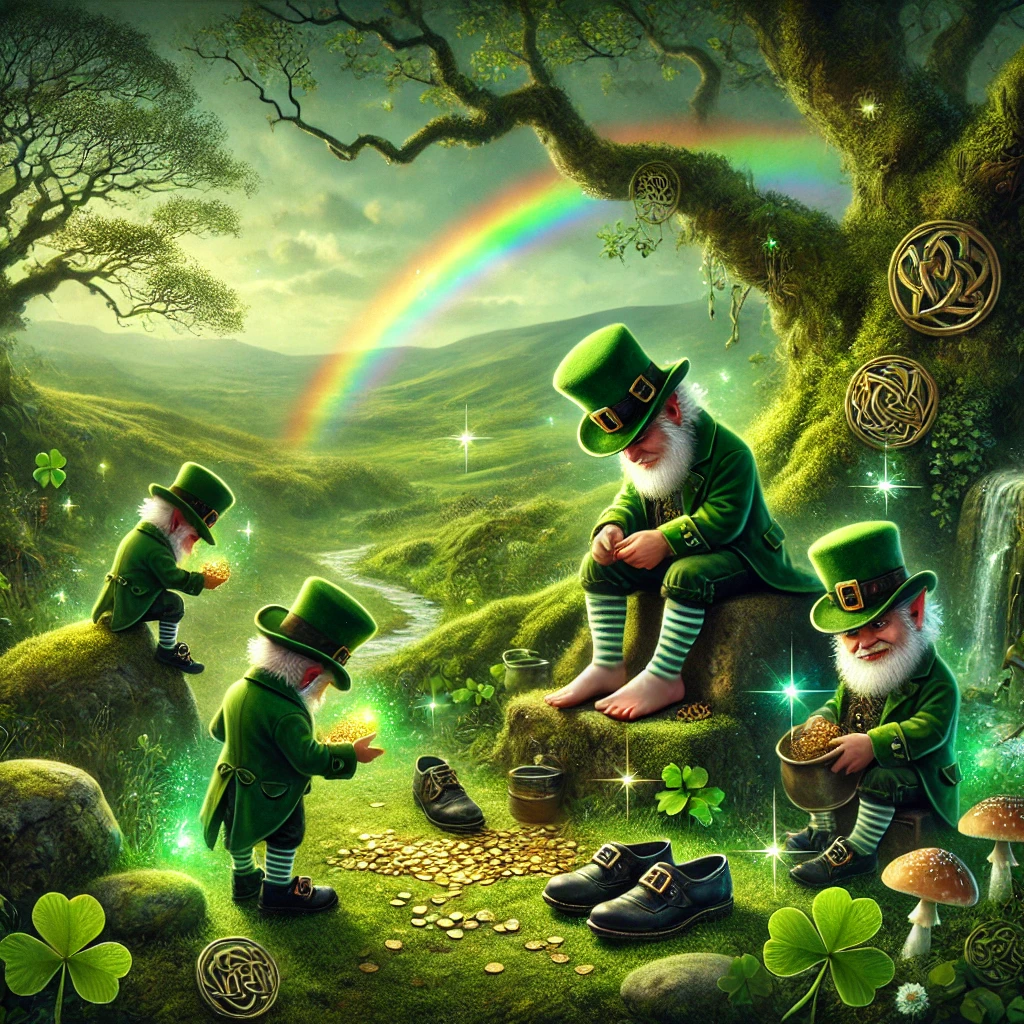Overview
Leprechauns are one of the most well-known nature spirits in Irish folklore—often portrayed as mischievous, clever, and elusive beings who guard hidden treasure and enjoy playing tricks on humans. But beyond the popularized image of green coats, gold coins, and rainbows, Leprechauns are deeply rooted in the mythological and spiritual traditions of Ireland, where they are considered a type of faery being (part of the Aos Sí, or “People of the Mounds”).
Traditionally, Leprechauns are understood as earth-bound spirits connected to the land, often associated with solitude, craftsmanship, and the old magic of Ireland’s wild places. As guardians of hidden wealth—both literal and symbolic—they remind humans to approach the invisible realms with humility, cleverness, and respect.
Origins and Etymology
- The term Leprechaun is derived from the Old Irish luchorpán, meaning “small body.”
- Early references describe them as water spirits or solitary faeries, evolving over time into shoemakers or cobblers known for their skill and secrecy.
- In Irish myth, Leprechauns are often linked to Tuatha Dé Danann ancestry—the ancient race of deities who became the Sídhe, or faery folk, after retreating into the Otherworld.
Nature and Appearance
| Attribute | Traditional Description |
|---|---|
| Size | Small, human-like in stature, often around 2–3 feet tall |
| Clothing | Red or green coats, buckled shoes, hats—each symbolizing craft or rank |
| Behavior | Solitary, clever, cautious, and sometimes mischievous or protective |
| Habitat | Remote woods, hedgerows, fairy mounds, and wild untamed landscapes |
Unlike many communal faery beings, Leprechauns are solitary in nature, preferring to live and work alone. They are often encountered near old trees, ancient ruins, or hidden glades, and rarely reveal themselves unless approached with great care.
Spiritual and Symbolic Significance
1. Guardians of Hidden Wealth
Leprechauns are famous for their pots of gold, which they hide in the Earth. In spiritual symbolism, this treasure often represents inner wisdom, ancestral gifts, or secret potential that lies buried within.
2. Masters of Craft and Resourcefulness
As legendary cobblers and craftspeople, Leprechauns symbolize the value of skill, discipline, and precision. Their dedication to their work reflects the importance of craftsmanship as a spiritual practice.
3. Trickster and Teacher
Leprechauns use cleverness and riddles to test human character. They reward honesty, humility, and wit, while punishing greed and arrogance. Their trickster aspect reflects a deeper initiation into the mystery of the unseen realms.
Encounters and Etiquette
1. Approach with Respect
- Leprechauns are not to be summoned or chased. They are independent beings who appear only on their own terms.
- If encountered, approach with reverence, curiosity, and humor, but never deceit.
2. Asking for Gifts or Guidance
- Leprechauns may offer clues, riddles, or symbolic “gifts” that lead to personal insight or hidden paths.
- Never try to trap or manipulate a Leprechaun—this will backfire or end in confusion and illusion.
3. Offerings
- Traditional offerings include whiskey, small coins, finely crafted items, or heartfelt music and poetry.
- Leprechauns are fond of laughter and clever wordplay, and appreciate offerings made with sincerity rather than expectation.
Signs of Leprechaun Presence
- Finding a small, intricately made item in nature (e.g., a shoe, miniature tool)
- Hearing distant tapping or hammering in the woods with no visible source
- Sudden shifts in perception or direction while walking through wild terrain
- A strong feeling of being watched playfully, but not malevolently
- Dreams involving keys, riddles, gold, or narrow forest paths
Leprechauns and the Land
Leprechauns are deeply tied to the spirit of place. They dwell in liminal spaces—the edges of meadows, the hollows of ancient trees, the mists that hover over forgotten ruins. Their energy is strongest in Ireland’s untouched landscapes, but they can be honored and worked with wherever the land is respected and wildness is welcomed.
They are also known to protect sacred places, punishing those who build on faery grounds or disturb ancient mounds. Many Irish locals continue to acknowledge their presence when working with the land, offering blessings and avoiding sacred faery paths.
Lessons and Teachings from Leprechauns
| Theme | Spiritual Lesson |
|---|---|
| Humility | True treasures are earned through patience and respect |
| Cleverness | Wit and wisdom go hand in hand in the unseen realms |
| Craftsmanship | Skill is a form of sacred expression |
| Independence | Know your own path. Guard your energy and focus |
| Respect for Nature | The land is alive. Honor it, or face unexpected consequences |
Conclusion
Leprechauns are far more than trickster characters of modern myth—they are earth-anchored spirits of wild places, ancient protectors of hidden wisdom, and symbolic keepers of personal and ancestral treasure. They call us to be clever yet kind, grounded yet open to magic, and to honor the unseen forces that weave through the land beneath our feet.
To walk the path of the Leprechaun is to walk with wit, respect, and the quiet joy of the secret keepers, learning that sometimes the greatest treasures are found not at the end of a rainbow, but in the heart of the forest, the depth of our craft, or the laughter shared with the Otherworld.

